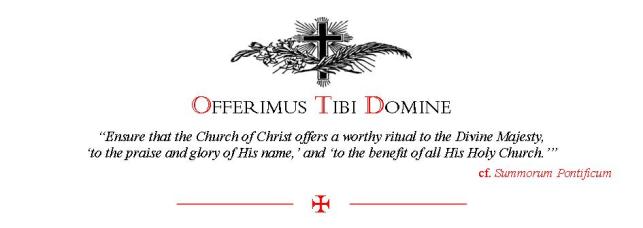I came across some reminders of proper Lenten liturgical practice by
Jimmy Atkin.
While practical needs and constraints might not let us do everything to the letter, it is always good to remind ourselves of the ideal and what we should be aiming at. So here are some of the reminders he gives.
1. Instrumental music with no singing. The simple Latin chants of the Mass at the Sanctus and Agnus Die are ideal for singing without accompaniment.
In some parishes, instrumental music is used at certain points during Mass. A passage will be played on an organ or on another instrument or instruments, even though nobody is singing.
But not in Lent (with a few exceptions).
The General Instruction of the Roman Missal (GIRM) states:
313. In Lent the playing of the organ and musical instruments is allowed only in order to support the singing. Exceptions, however, are Laetare Sunday (Fourth Sunday of Lent), Solemnities, and Feasts.
2. Flowers on the altar.
It is common for the altar to be decorated with flowers during most of the year. That is, there will be flowers around the altar, though NOT on top of the altar table itself. The artistically(?) arranged posy bowls should never be actually on the mensa, the altar top. The re-table or shelf behind the altar was always the place for these. Now that many ad orientem altars have been abandoned for a forward facing table, this has led to all sorts of "decorations" appearing on the consecrated mensa top (other than Father's spectacles!)
Flowers should not about the altar in Lent (with a few exceptions).
The General Instruction states:
305. During Lent it is forbidden for the altar to be decorated with flowers. Exceptions, however, are Laetare Sunday (Fourth Sunday of Lent), Solemnities, and Feasts.
3. Emptying holy water fonts. I've heard of this here and there. Very odd!
In recent years, some parishes have taken the holy water out of the holy water fonts during Lent. They have even filled them with sand in some cases. The idea, they say, is to convey the thought that Lent is a time of spiritual dryness--a "desert" experience--that precedes Easter, in which we refrain from using the sacramental of holy water. Despite its popularity in some places, this practice is not permitted. It has been the Church's practice to empty the holy water fonts during the Sacred Triduum, but for a different reason. It is not permitted to have them empty through the whole season of Lent.
The Congregation for Divine Worship has stated:
This Dicastery is able to respond that the removing of Holy Water from the fonts during the season of Lent is not permitted, in particular, for two reasons:
1. The liturgical legislation in force does not foresee this innovation, which in addition to being "praeter legem" [i.e., "apart from the law"] is contrary to a balanced understanding of the season of Lent, which though truly being a season of penance, is also a season rich in the symbolism of water and baptism, constantly evoked in liturgical texts.
2. The encouragement of the Church that the faithful avail themselves frequently of the sacraments is to be understood to apply also to the season of Lent. The "fast" and "abstinence" which the faithful embrace in this season does not extend to abstaining from the sacraments or sacramentals of the Church.
The practice of the Church has been to empty the Holy Water fonts on the days of the Sacred Triduum in preparation of the blessing of the water at the Easter Vigil, and it corresponds to those days on which the Eucharist is not celebrated (i.e., Good Friday and Holy Saturday) [3/14/03: Prot. N. 569/00/L].
4. Veiling crosses and statues before the Fifth Sunday of Lent.
In recent years, some parishes in the United States have veiled or otherwise removed crosses and statues as soon as Lent begins. They're jumping the gun. This practice is permitted beginning with the Fifth Sunday of Lent, but not before.
The Roman Missal states:
The practice of covering crosses and images throughout the church from this [Fifth] Sunday may be observed.
Crosses remain covered until the end of the Celebration of the Lord's Passion on Good Friday, but images remain covered until the beginning of the Easter Vigil.
Notice that the practice is optional (the practice "may be observed" not "is to be observed").
If it is not observed, in a particular parish, from the Fifth Sunday of Lent, there is additional encouragement to do remove or veil crosses after the Mass of the Lord's Supper on Holy Thursday.
The rubrics in the Roman Missal for that day state:
At an appropriate time, the altar is stripped and, if possible, the crosses are removed from the church.
It is expedient that any crosses which remain in the church be veiled.









.jpg)









